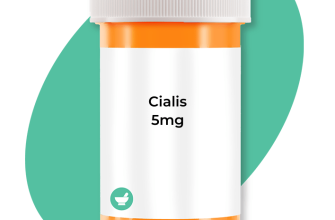Consider exploring the potential benefits of Cialis in managing specific scleroderma symptoms. Research suggests that its vasodilatory properties may offer relief from Raynaud’s phenomenon, a common and debilitating complication of the disease. This improvement in blood flow can lead to reduced pain and improved circulation in affected extremities.
However, it’s crucial to remember Cialis is not a cure for scleroderma. Its use should be discussed thoroughly with your physician. They can assess your individual needs and determine if the potential benefits outweigh the risks. Regular monitoring of blood pressure and other relevant health parameters will be necessary.
Clinical trials exploring Cialis’s role in scleroderma are ongoing. These studies aim to provide more concrete evidence regarding its efficacy and long-term effects. Meanwhile, a personalized treatment plan, created in collaboration with your rheumatologist, remains the cornerstone of effective scleroderma management. This plan should also include strategies to manage other symptoms and complications.
Remember: This information is for educational purposes only and does not constitute medical advice. Always consult your doctor before starting or stopping any medication, especially if you have pre-existing health conditions. They will provide personalized guidance based on your unique situation and medical history.
- Cialis for Scleroderma: Exploring Potential Benefits and Limitations
- Understanding the Symptoms and Challenges of Scleroderma
- Cialis’s Mechanism of Action and Potential Relevance to Scleroderma
- Vascular Dysfunction in Scleroderma
- Potential Therapeutic Implications
- Areas for Further Research
- Conclusion
- Preliminary Research and Case Studies: Evidence for Cialis’s Use in Scleroderma
- Potential Side Effects and Risks of Cialis for Scleroderma Patients
- Cardiovascular Risks
- Interactions with Other Medications
- Gastrointestinal Issues
- Other Potential Side Effects
- Current Recommendations and Future Research Directions for Cialis in Scleroderma Treatment
Cialis for Scleroderma: Exploring Potential Benefits and Limitations
Currently, there’s no FDA-approved use of Cialis (tadalafil) for scleroderma. However, research explores its potential in managing certain scleroderma-related complications.
One area of interest is pulmonary arterial hypertension (PAH), a serious complication of scleroderma. Tadalafil’s vasodilatory properties may improve blood flow in the lungs, potentially easing PAH symptoms. Studies show mixed results, with some indicating benefits in improving exercise capacity and reducing PAH-related symptoms. However, larger, more rigorous clinical trials are needed to confirm these findings and determine optimal dosage and treatment duration.
- Potential Benefit: Improved pulmonary function and exercise tolerance in patients with scleroderma-associated PAH.
- Limitation: Inconclusive clinical evidence; further research is necessary to establish efficacy and safety.
Another potential application involves improving Raynaud’s phenomenon, characterized by painful spasms in the fingers and toes. Tadalafil’s vasodilating effects could theoretically reduce the severity and frequency of these episodes. Again, studies are limited, and more research is needed before any definitive conclusions can be drawn.
- Potential Benefit: Reduced frequency and severity of Raynaud’s attacks.
- Limitation: Lack of substantial clinical data supporting this application.
It’s crucial to remember that tadalafil isn’t a cure for scleroderma. Its potential role is limited to addressing specific complications. Always discuss any potential off-label use of Cialis with your doctor. They can assess your individual situation, consider potential risks and benefits, and determine whether it’s appropriate for you. Self-medicating is strongly discouraged.
- Consult your physician before using tadalafil for scleroderma-related complications.
- Be aware of potential side effects, including headache, flushing, and indigestion.
- Regularly monitor your condition and report any changes to your doctor.
Understanding the Symptoms and Challenges of Scleroderma
Scleroderma presents diversely, making diagnosis challenging. Common symptoms include thickened skin, often beginning in the hands and fingers, leading to reduced mobility and joint pain. Raynaud’s phenomenon, characterized by finger and toe discoloration in response to cold, is prevalent. Internal organ involvement is a significant concern.
Gastrointestinal issues, such as difficulty swallowing (dysphagia) and reflux, are common. Lung problems, including pulmonary hypertension and interstitial lung disease, can severely impact breathing and quality of life. Kidney involvement, manifested as scleroderma renal crisis, is a life-threatening complication requiring prompt medical attention.
Fatigue is a pervasive symptom, impacting daily activities and overall well-being. Muscle weakness and joint pain further restrict physical capabilities. These symptoms significantly affect daily life and require careful management. Regular medical check-ups are crucial for early detection of complications.
Managing scleroderma requires a multidisciplinary approach, involving rheumatologists, pulmonologists, nephrologists, and other specialists as needed. Treatment focuses on symptom management and slowing disease progression. This might include medications to manage pain, improve organ function, and address specific complications.
Patients should actively participate in their care by maintaining open communication with their healthcare team. Lifestyle modifications, such as stress reduction techniques and regular exercise (as tolerated), can improve overall health. Joining support groups can provide emotional support and valuable peer-to-peer information sharing.
Cialis’s Mechanism of Action and Potential Relevance to Scleroderma
Cialis, or tadalafil, primarily inhibits phosphodiesterase-5 (PDE5). This enzyme breaks down cyclic guanosine monophosphate (cGMP), a molecule crucial for vascular smooth muscle relaxation. By blocking PDE5, Cialis increases cGMP levels, leading to vasodilation and improved blood flow.
Vascular Dysfunction in Scleroderma
Scleroderma involves widespread vascular dysfunction. Excessive collagen deposition and inflammation damage blood vessels, restricting blood flow to organs and tissues. This reduced perfusion contributes to the disease’s characteristic symptoms, including Raynaud’s phenomenon and organ damage.
Potential Therapeutic Implications
Cialis’s vasodilatory effects offer a potential therapeutic avenue. By improving blood flow, it might alleviate some scleroderma symptoms, particularly those related to Raynaud’s phenomenon. However, it’s crucial to note that clinical evidence supporting Cialis’s efficacy in treating scleroderma is currently limited. More research is necessary to determine its true role.
Areas for Further Research
Future studies should focus on:
| Research Area | Specific Goal |
|---|---|
| Clinical Trials | Well-designed randomized controlled trials evaluating Cialis’s efficacy in managing scleroderma symptoms. |
| Dosage Optimization | Determining the optimal dosage and duration of Cialis treatment for scleroderma patients. |
| Patient Subsets | Identifying specific patient subpopulations who might benefit most from Cialis therapy. |
| Adverse Effects Monitoring | Thorough monitoring of potential adverse effects associated with Cialis use in scleroderma patients. |
Conclusion
While Cialis’s mechanism of action suggests a potential role in treating vascular complications of scleroderma, definitive clinical evidence remains lacking. Further research is needed before firm recommendations can be made.
Preliminary Research and Case Studies: Evidence for Cialis’s Use in Scleroderma
While large-scale clinical trials specifically investigating Cialis for scleroderma are lacking, several preliminary studies and case reports suggest potential benefits in managing certain aspects of the disease. These studies primarily focus on Cialis’s impact on pulmonary arterial hypertension (PAH), a serious complication of scleroderma. One small study showed improved hemodynamics in scleroderma patients with PAH after Cialis treatment, indicating a possible improvement in blood flow to the lungs.
Furthermore, case reports document positive effects on Raynaud’s phenomenon, a common scleroderma symptom characterized by reduced blood flow to the extremities, following Cialis administration. These observations suggest a potential vasodilatory effect, improving blood vessel function. However, the observed improvements were not consistent across all cases, emphasizing the need for further investigation.
Another area of interest involves Cialis’s potential role in treating skin fibrosis, a hallmark of scleroderma. Limited preclinical research shows that tadalafil, the active ingredient in Cialis, may inhibit the production of collagen, a key component of scar tissue. This suggests a potential mechanism for reducing fibrosis, but human studies are necessary to validate this finding.
It’s crucial to understand that the existing evidence is preliminary and inconclusive. The available data primarily comes from small studies and case reports, limiting the ability to draw definitive conclusions regarding Cialis’s efficacy and safety in treating scleroderma. Larger, well-designed clinical trials are required to confirm these initial findings and determine the appropriate dosage and patient selection criteria.
Patients considering Cialis for scleroderma should discuss this option thoroughly with their rheumatologist or pulmonologist. They should carefully weigh potential benefits against potential risks and closely monitor for any adverse effects. Self-medicating with Cialis is strongly discouraged.
Potential Side Effects and Risks of Cialis for Scleroderma Patients
Cialis, while effective for erectile dysfunction, isn’t currently approved to treat scleroderma. Using it off-label carries potential risks, especially for individuals with pre-existing conditions. Always consult your doctor before using Cialis, or any medication, if you have scleroderma.
Cardiovascular Risks
Scleroderma can impact the cardiovascular system. Cialis, by relaxing blood vessels, might exacerbate pre-existing cardiovascular issues. Patients should carefully monitor blood pressure and report any unusual symptoms such as chest pain or shortness of breath to their physician immediately. This is particularly important for individuals with hypertension or a history of heart problems. Your doctor can assess your risk and determine if Cialis is safe for you.
Interactions with Other Medications
Many individuals with scleroderma take multiple medications. Cialis can interact negatively with some drugs, potentially leading to adverse effects. Provide your physician with a complete list of all medications, supplements, and herbal remedies you are taking to avoid dangerous interactions. This open communication is crucial for safe and effective treatment.
Gastrointestinal Issues
Headaches, indigestion, and back pain are common side effects reported with Cialis. These effects might be amplified in scleroderma patients due to the disease’s impact on the digestive tract. Discuss any gastrointestinal concerns with your healthcare provider to manage potential complications.
Other Potential Side Effects
Less common, but still possible, side effects include vision changes, hearing loss, and muscle aches. Promptly report any new or worsening symptoms to your doctor. They can help determine if these are related to Cialis and suggest appropriate management strategies.
Remember, this information is for educational purposes and shouldn’t replace professional medical advice. Always consult your physician before starting any new medication, especially if you have scleroderma.
Current Recommendations and Future Research Directions for Cialis in Scleroderma Treatment
Currently, Cialis is not a recommended treatment for scleroderma. There’s insufficient clinical evidence supporting its efficacy in managing scleroderma symptoms or disease progression.
However, preclinical studies show potential benefits of tadalafil (the active ingredient in Cialis) in addressing some scleroderma-related complications. These studies suggest mechanisms including improved vascular function and reduced fibrosis.
- Future research should focus on well-designed clinical trials to evaluate tadalafil’s efficacy and safety in diverse scleroderma populations.
- These trials should specifically investigate its impact on key scleroderma symptoms, like Raynaud’s phenomenon and skin fibrosis.
- Researchers should also explore optimal dosing regimens and potential synergistic effects when combined with existing scleroderma treatments.
Furthermore, investigation into the underlying mechanisms by which tadalafil might influence scleroderma pathogenesis is critical. This includes exploring its effects on:
- Vascular tone and remodeling
- Fibroblast activation and collagen production
- Immune cell function
Biomarker studies are also needed to identify potential predictors of response to tadalafil, helping personalize treatment strategies. This could ultimately lead to more targeted therapies for specific subsets of scleroderma patients.
Data from these future research initiatives will be crucial in determining if Cialis has a role in the treatment of scleroderma. Until then, patients should rely on established treatment guidelines for their condition.









